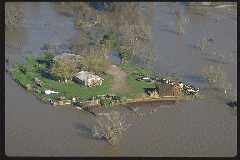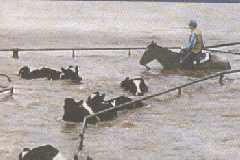The immediate danger from flash floods is the strength of the water current as it surges through an area, carrying debris
and causing injuries and drowning. This is traditionally of particular concern for
farms and livestock, but it also has significant implications in hilly urban areas
which have limited routes of egress.
- Floods can interrupt power, disable fuel sources and make roads impassable.
- People may be stranded in their homes or be unable to reach their homes.
- Landslides may follow flooding.
Seconds may make the difference between life and death. If you hear of a flash flood warning on the radio or television
or hear the roar of approaching waters, act immediately.
- Head for the nearest high ground without hesitation, bringing with you livestock and
animals in danger if it is feasible to do so.
- Even if you are not sure where to take your animals, do not leave them behind unless it would compromise your safety.
- If you must leave an animal behind, make sure it always has an escape route. Never tie an animal up if floods are
pending. Many animals have died during floods when owners left them confined.
During the recovery process, safety precautions may prevent further damage. Listed below are some precautions that will help
you as you recover from a flood.
- Do not use food that has come in contact with flood waters. This includes any feed for
animals. If there is a boil water order in effect, continue to take this precaution until officials
tell you that the tap water is safe to drink. Do not give animals tap water until it has been boiled
or determined safe. Wells should be flushed out, disinfected and tested before drinking from them.
- Before entering any building (residence, outbuilding, barn, etc), check for structural damage. Also look
for any poisonous snakes or wildlife that may have gotten trapped inside buildings or barns.
- When entering a building, open the building and let it air out for several minutes to remove foul odors or escaped gas
before entering. Do not use a match or lantern as a source of light because of the possibility of gas buildup. A
battery powered flashlight is recommended.
- Once inside a building, check for electrical shorts and live wires. Make sure the power is turned off and do not use any electricity
until an electrician has checked your system. Report downed or broken utility lines to local authorities.
- Open all doors and windows to help dry the building. Shovel out mud
while it is still moist to give walls and floors an opportunity to dry. If horses or livestock have to stand
in mud for extended periods, they can develop foot problems.
- In barns, empty any water containers that contain flood water, and be sure to clean them with dilute chlorine bleach or some
other type of disinfectant before they are used again. Any feed or bedding that has gotten wet or damp must be disposed of
so that animals cannot eat it. Moldy food can lead to serious disease in horses and livestock.
- Before horses or livestock are turned out onto property that has flooded, be sure that all perimeter fences
are intact and all debris has been removed.
Source: FEMA Publication IS-010
|


